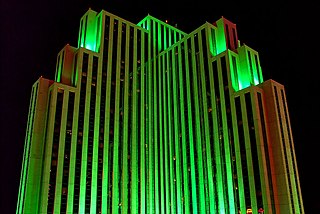See also
- Silver Slipper Casino (Waveland), a casino in Hancock County, Mississippi,
- Silver Slipper Stakes, an Australian horse race
Silver Slipper or The Silver Slipper may refer to:

The Las Vegas Strip is a stretch of Las Vegas Boulevard in Clark County, Nevada, that is known for its concentration of resort hotels and casinos. The Strip, as it is known, is about 4.2 mi (6.8 km) long, and is immediately south of the Las Vegas city limits in the unincorporated towns of Paradise and Winchester, but is often referred to simply as "Las Vegas".

The New Frontier was a hotel and casino on the Las Vegas Strip in Paradise, Nevada. The property began as a casino and dance club known as Pair O' Dice, opened in 1931. It was sold in 1941, and incorporated into the Hotel Last Frontier, which began construction at the end of the year. The Hotel Last Frontier opened on October 30, 1942, as the second resort on the Las Vegas Strip. The western-themed property included 105 rooms, as well as the Little Church of the West. The resort was devised by R.E. Griffith and designed by his nephew, William J. Moore. Following Griffith's death in 1943, Moore took over ownership and added a western village in 1948. The village consisted of authentic Old West buildings from a collector and would also feature the newly built Silver Slipper casino, added in 1950.
The Castaways was a hotel and casino on the Las Vegas Strip in Paradise, Nevada. It began in the 1930s, as a small motel called Mountain View. It became the San Souci in 1939, and underwent several ownership changes in its early years. A hotel addition opened on August 21, 1955, when the property became the Sans Souci Hotel. A casino, showroom, and restaurant were eventually opened on October 23, 1957. These facilities closed less than a year later, due to financial problems, although the hotel continued operations. Following a bankruptcy reorganization, the shuttered facilities reopened in May 1960. However, the property soon closed due to further financial difficulties.
The Silver Slipper was a casino on the Las Vegas Strip in Winchester, Nevada. It opened on September 1, 1950. It was built just north of the Frontier hotel-casino, and they both shared the same ownership, although the Silver Slipper's gaming operations were later leased out. Businessman Howard Hughes leased the casino from 1968 until his death in 1976.

Mermaids Casino was a casino located on the Fremont Street Experience in Downtown Las Vegas, Nevada.
Martin Stern Jr. was an American architect who was most widely known for his large scale designs and structures in Las Vegas, Nevada. He is credited with originating the concept of the structurally integrated casino resort complex in Las Vegas.
Silver Slipper Casino is a name that has been used by several casinos including:

Silver Slipper Casino is a beachfront casino and hotel in Hancock County, Mississippi, owned and operated by Full House Resorts. The casino has over 961 slots, 28 table games, a keno parlor and a sports book. Dining options include a buffet, a 24-hour café, a fine dining restaurant, and an oyster bar.
Beldon Katleman was an American businessman. Katleman inherited partnership in El Rancho Vegas, a hotel casino in Las Vegas, Nevada, from his uncle Jake Katleman who died in 1950, and served as president of the hotel. Katleman was an investor in two other Las Vegas casinos, the Frontier Hotel and the Silver Slipper.

YESCO is a privately owned manufacturer of electric signs based in Salt Lake City, founded by Thomas Young in 1920. The company provides design, fabrication, installation and maintenance of signs.

The Silver City Casino was a casino on the Las Vegas Strip in Winchester, Nevada.

Silver Legacy Resort & Casino is a hotel and casino located in Downtown Reno, Nevada. It anchors a network of connected hotel-casinos in the downtown Reno core that included Circus Circus Reno and Eldorado Reno and are owned and operated by Caesars Entertainment. It has over 1,700 hotel rooms and suites and is the tallest building in Reno.
The Silver Nugget is a casino and arena located on Las Vegas Boulevard North in North Las Vegas, Nevada. The casino is owned and operated by Fifth Street Gaming. The casino site covers 14 acres (5.7 ha) and includes a 14,000 sq ft (1,300 m2) arena.

Silver Sevens is a hotel and locals casino 1 mile (1.6 km) east of the Las Vegas Strip, in Paradise, Nevada. It is owned and operated by Affinity Interactive. Silver Sevens has 327 rooms and a 30,225 sq ft (2,808.0 m2) casino.
West Las Vegas is a historic neighborhood in Las Vegas, Nevada. This 3.5 sq mi (9.1 km2) area is located northwest of the Las Vegas Strip and the "Spaghetti Bowl" interchange of I-15 and I-11/US 95. It is also known as Historic West Las Vegas and more simply, the Westside. The area is roughly bounded by Carey Avenue, Bonanza Road, I-15 and Rancho Drive.

Poker Palace is a locals casino located at 2757 North Las Vegas Boulevard in North Las Vegas, Nevada, near Nellis Air Force Base.
Major Arteburn Riddle was an American businessperson who owned several casinos in the Las Vegas area.